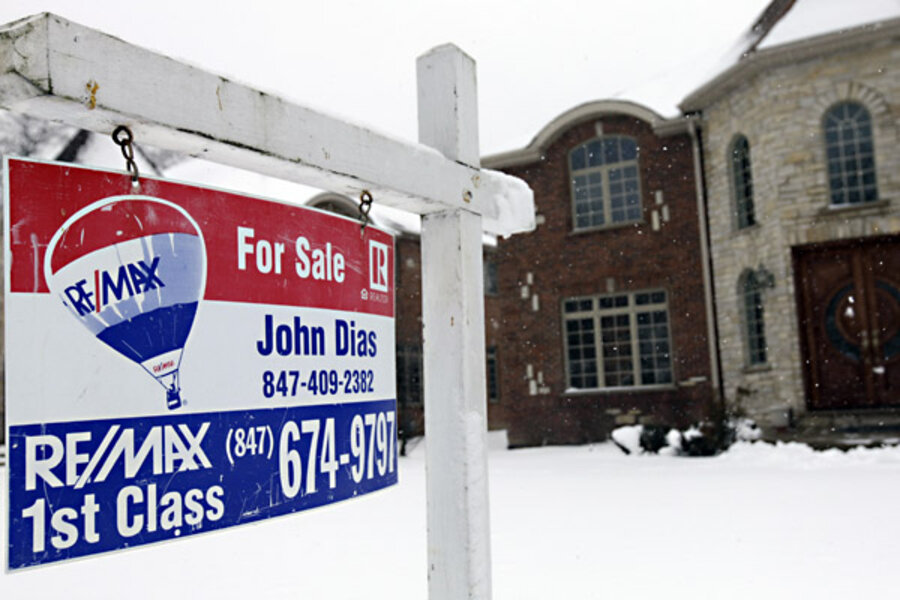Home sales rise in February, but is the market really improving?
Loading...
If you've been following US real estate recently, you know that it's a “seller’s market” marked by “favorable buying conditions.”
There is “pent up demand” that is limited by ”tight credit standards.”
Confused? Figuring it all out can be maddening, since there's truth in all the above claims. What is clear is that the housing market has bottomed out from an historic slump. As residential real estate makes a slow but steady recovery – a trend that continued in February, according to a new report – it is exhibiting some (but not all) of the characteristics of last decade's housing bubble. Demand is high, supply is low. But prices are not rising at the rate one would expect.
“It’s just a weird market," says Daren Blomquist, vice president of RealtyTrac, an online marketplace for foreclosure properties based in Irvine, Calif. “In a sense, it is a seller’s market. It just takes more work on the part of the buyer. You can still get properties at relatively low price, but you may have to put in several offers to get it.
The housing market had yet another good month in February. Existing home sales increased 0.8 percent, to 4.98 million on the year, a 10.8 percent increase since February of last year, the National Association of Realtors reported Thursday. February home sales hit their highest levels since November 2009. Nationally, the months’ supply of homes increased slightly, from 4.3 in January to 4.7 in February
“Job growth in the improving economy and pent-up demand are causing both home sales and rental leasing to rise,” NAR Chief Economist Lawrence Yun said in the NAR’s monthly release.
New homes showed similar growth. Housing starts increased by 0.8 percent last month to 917,000 on the year, the Commerce Department reported earlier this week. Housing permits, meanwhile, jumped 4.8 percent, their biggest increase since 2008.
But further growth in home sales is being hampered by a limited inventory in some markets, real estate agents argue. Boston is one example.
“Here, the market for the first 80 days of the year has been a seller’s market,” says Paul Mydelski, a broker/owner with Re/Max Leading Edge in the greater Boston area. “Inventory is tight, more demand and supply.... “In our more competitive spots, homes go quickly. It isn’t unusual to have 10 or 15 offers" on a property.
Those conditions are reminiscent of the housing bubble. Median home prices have increased 8.9 percent in Massachusetts since last year, while inventory has dropped by a little over 10,000 homes, according to Re/Max data. That's good price appreciation, but not a boom.
New England was dealt a relatively soft blow by the housing bust. Yet, the confluence of low prices and tight demand is being seen in other parts of the country as well.
From the buyer’s standpoint, “If you’re willing to price your home right you will sell it very quickly,” says Mr. Blomquist of RealtyTrac. But the bidding wars won’t drive up prices in the same way they went up during the housing boom, because prices are being held in check by tighter lending standards, he adds. “It’s a seller’s market from a demand standpoint, but not a price standpoint.”
The low inventory is driven by two factors: In states with lengthy foreclosure processes, like Florida and Illinois, there’s what analysts call a “shadow inventory” of foreclosed homes that have yet to be released onto the market. The other issue is potential sellers who either lack the equity to put their homes up for sale, or are waiting for prices to rise further before they list. Both Blomquist and Mr. Mydelski expect these trends to ease in the coming months, as the shadow inventory is released and price appreciation lead to greater home equity and more potential sellers.
In foreclosure-heavy areas, like parts of Florida and Chicago, this easing could start to weaken price appreciation in the coming months, “but most people will be happy about that,” Blomquist says. More inventory will stimulate those economies with more sales. Plus, foreclosures are usually in need of repairs, so that trickles down to the home-improvement sector.
He warns that housing isn’t quite out of the woods yet. “There are a lot of reasons for hope going forward, but the two biggest risks are the high number of underwater homeowners, which means the market is not completely healthy, and then the lingering foreclosures in the next year and a half. But even those risks seem to be manageable as long as there isn’t another big shot at the economy.”
Mydelski agrees, but warns not to put too much stock into national trends. “Real estate is local,” he says. "These national forecasts are like watching the national weather, it doesn’t mean anything to you. It varies from neighborhood to neighborhood, street to street.”








